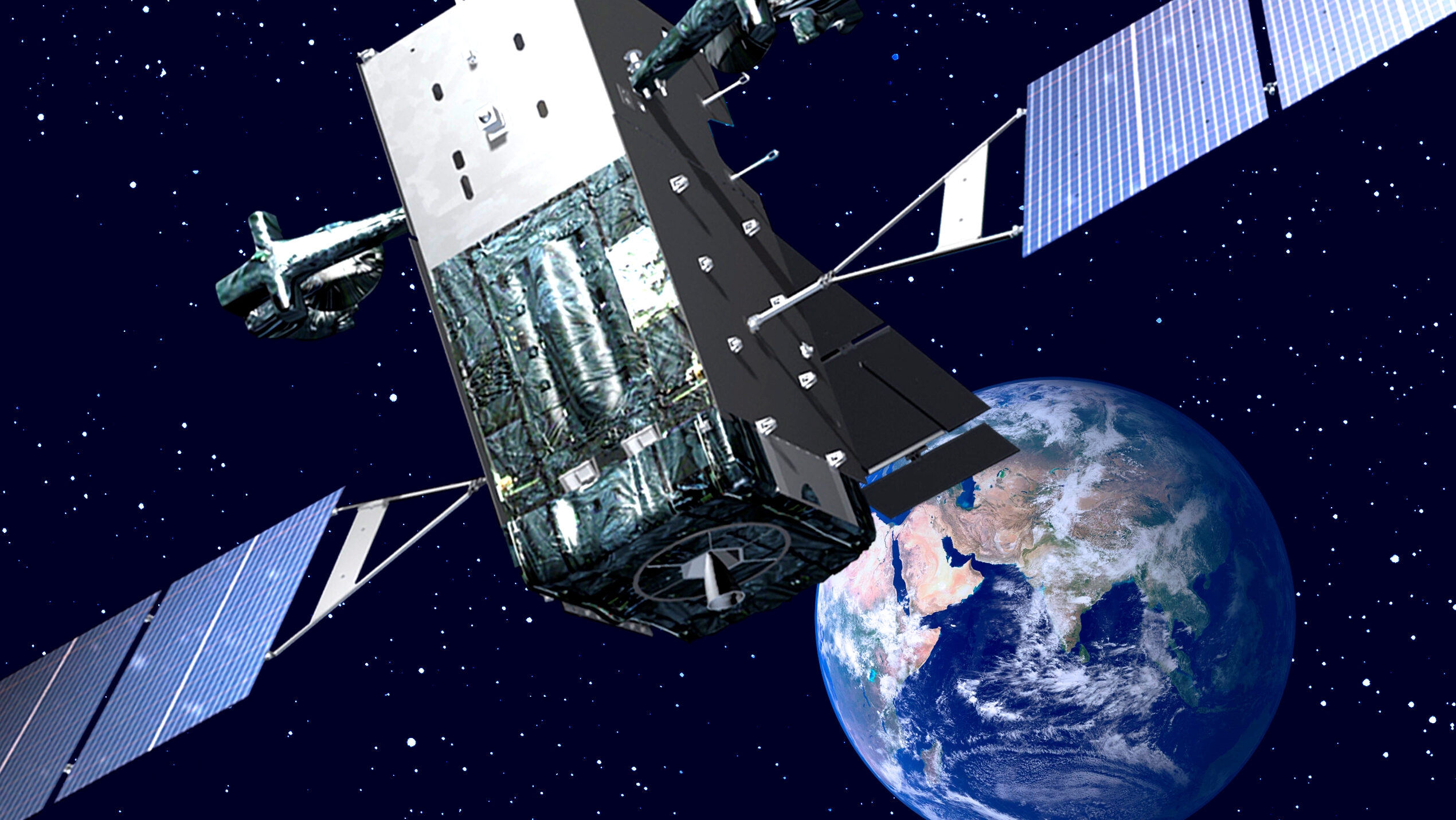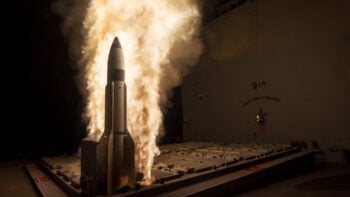
Current SBIRS missile warning satellites (pictured) will be replaced by the Next Gen OPIR constellation. (Credit Lockheed Martin, via US Air Force)
WASHINGTON: The Senate Armed Services Committee has joined a growing chorus concerned that the acquisition authority designed to speed prototyping of innovative technologies is instead being used for other purposes — potentially creating budgetary and performance problems down the line.
As a result, the SASC’s version of the fiscal 2023 National Defense Authorization Act calls for tighter Pentagon management oversight of “Middle Tier of Acquisition (MTA)” authorities.
“The committee is supportive of using the MTA pathway to rapidly develop and deploy innovative technologies and capabilities to operational units. However, the committee is concerned that the desire for speed in these programs could lead to the omission of key elements of good program management,” the SASC’s report on their annual defense policy bill, released publicly July 18, states.
“Therefore, the committee believes that MTA programs and the associated stakeholders would benefit from a clear transition plan, life-cycle cost estimate, and test plan,” the report adds. The lawmakers thus instruct Defense Department acquisition executives to ensure that a full acquisition plan is created within one year of designating a program for MTA use.
Section 804 MTA authorities originally were created by Congress in 2016 to allow rapid prototyping and/or rapid fielding of breakthrough technologies in part by waiving certain requirements of federal acquisition law for measuring performance. Under MTA, program managers can forgo a number of oversight activities such as certain planning reports and independent cost assessments. The law specifically limits the lifetime of MTA efforts to five years, unless an extension is granted by senior DoD acquisition executives.
But over the past two years as the Pentagon has emphasized a need for speed, there has come increasing agitation about the proliferation of MTA-designated programs. And it’s not just the Senate: at various points, House lawmakers and the GAO have also raised flags. The concerns run the gamut, from the use of MTAs being used not for prototyping but instead to more rapidly field already operational systems; failure to fully fund MTA programs over their short life cycles; and the dodging of oversight for major programs of record by using multiple MTAs for different parts of the system.
Eric Lofgren, a defense acquisition specialist at George Mason University, told Breaking Defense that “GAO and OSD [the Office of the Secretary of Defense] seem to be struggling with how to baseline and conduct oversight of these programs.”
The issue, he explained, is how to ensure proper oversight without re-creating the red tape that MTAs were designed to avoid in order to speed development.
“Congress and other oversight stakeholders will need transparency and some measure of control over these MTA efforts that evolve over time. If they cannot rely on Acquisition Program Baselines to measure cost growth, then what is the method of oversight in a dynamic, innovative world?” Lofgren wrote in his daily acquisition blog back in April.
Before SASC, GAO Frets Over 17 ‘Major’ Programs
Before the SASC bill was made public, the House and Senate Appropriations Committees raised questions about the Pentagon’s growing predilection for using MTAs not to prototype new technology, but to instead develop and buy full-up operations systems.
For example, the Senate Appropriations defense subcommittee’s FY21 spending bill chided:
“The Committee is concerned that the services’ growing trend toward procuring de facto operational assets via prototyping acquisitions may limit the services’ ability to successfully manage their acquisition programs in the long-term by eliminating the full understanding of long-term program costs up- front; unnecessarily narrowing down the industrial base early in the acquisition process; and eliminating opportunities for future innovation by reducing competitive opportunities over the life of the acquisition.”
GAO has expressed similar concerns. In an April 2021 report on DoD acquisition reform, the GAO found that “DOD plans to invest about $31 billion in current MTA programs, but cost reporting continues to be inconsistent. … We also identified other reliability concerns with MTA program data submitted to OSD and Congress.”
GAO stressed that many MTA programs are being based on “incomplete business cases.” Thus, they “face increasing risk that they will fall short of expected performance goals as a result of starting without sound business cases.”
GAO also found that of the 19 MTAs it reviewed, 17 exceeded the monetary thresholds for a “Major Defense Acquisition Program” that normally would require tight DoD and congressional oversight. Ten of the 17 were Air Force/Space Force programs; the Navy had one; and the Army, six.
In particular, GAO and lawmakers have raised their collective eyebrows about the practice, used often by the Space Force, of breaking out pieces of larger programs of record — such as the multi-billion NextGeneration Overhead Persistent Infrared System missile warning satellite development program — and designating those sub-systems as MTAs.
Asked about the issues, a Defense Department spokesperson explained that service acquisition chiefs, as well as defense agencies with acquisition authorities, can designate any program falling under the major acquisition threshold an MTA, but that Undersecretary of Defense for Acquisition and Sustainment Bill LaPlante must approve MTA status for programs exceeding it. (That threshold is $525 million for research, development, test and evaluation funding and $3.065 billion for procurement funding, both in constant FY20 dollars.)
In addition, the spokesperson said, “The Under Secretary of Defense (Comptroller) reviews that amount that is budgeted in the Future Years Defense Program (FYDP) to ensure that the Component has allocated sufficient funds to execute the program approved by the USD(A&S).”
An ‘Essential’ Tool
But the FY23 budget request documents for the Air Force and the Space Force show that a number of MTA programs launched by the newest service actually do not meet DoD’s own internal requirements that they be fully funded within their five-year lifecycle.
For each of the MTA programs without full funding, the budget justification books (J-books) simply state: “The Department of the Air Force is assessing all options to address the funding shortfalls for MTA programs including additional funding in a future budget request, performance trades based on technical maturity, or transition to alternative pathways.”
For the Space Force, these include the high-priority Deep Space Advanced Radar effort and long-awaited GPS ground receivers capable of receiving the encrypted M-Code. For the Air Force, one such program is the F-15EX.
Indeed, the House Appropriations defense subcommittee in its version of the FY23 defense spending bill excoriated the Space Force in particular for starting programs that it cannot currently afford to take to fruition and lacking a “credible five-year budget.”
Notably, the SAC in FY21 demanded that the comptroller actually certify that each MTA is fully funded for its five-year duration; while SAC cannot set legal boundaries for the Pentagon’s use of MTAs, it wields enormous influence as the controller of the purse strings. The DoD spokesperson confirmed “It is DoD policy that all Middle Tier Acquisition (MTA) programs be fully funded.”
Still, for all lawmakers’ worry, even the SASC NDAA report seeks to ensure that the Space Development Agency can continue to use both MTA and Other Transaction Authority provided under Section 804 when it shift over to the Space Force in October.
“The committee believes it is essential that the Secretary of the Air Force, acting through the Service Acquisition Executive for Space, fully support the Space Development Agency’s utilization of these and other authorities to ensure the rapid fielding of existing and future satellite systems and architectures, while ensuring that there is also a clear transition plan, life-cycle cost estimate, and test plan.”
Marines prioritize ‘complimentary’ mix of loitering munitions with new contract
Two of the vendors for the Organic Precision Fires-Light (OPF-L) System Development Contract are providing vertical take-off/launch (VTOL) solutions, while the third is going for a fixed-wing solution.


























